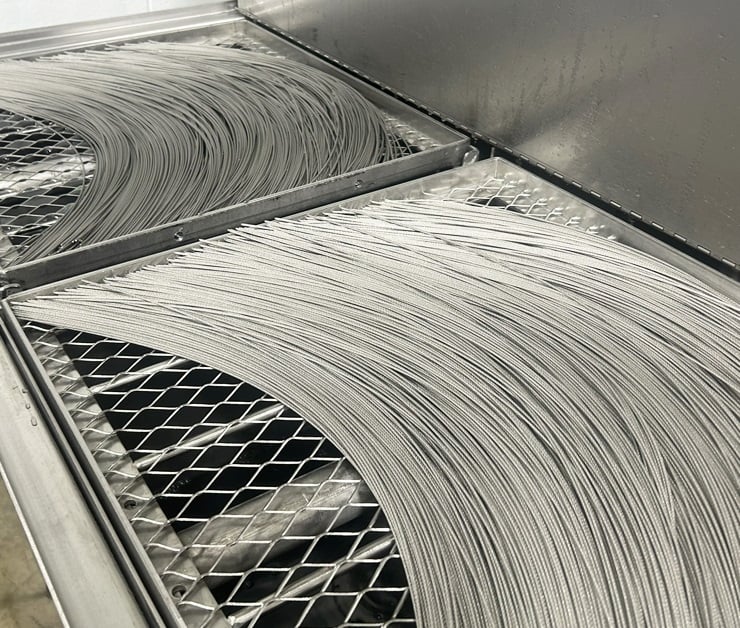
Ultrasonic cleaning of wire rope is the act of submerging a length of mechanical cable or mechanical cable assemblies in a bath solution that applies high-frequency sound waves to the wire rope’s exposed surfaces. These seemingly silent waves of sound dissolve the majority of both charged, mineral ions, and the uncharged non-ionic molecules present on the cable’s surfaces.
Ultrasonic cleaning of wire rope is appropriate where the dangers posed to wire rope by both charged and uncharged impurities could represent a genuine threat to the cable itself, and likewise be potentially harmful to neighboring components, systems, and as you’ll read later, even humans.
For these reasons, the water and bath solutions used to ultrasonically clean mechanical cables are both a critical consideration and not at all one-size-fits-all.
After all, charged mineral ions, such as salt, calcium, magnesium, and iron, are natural conductors of electricity, and differently, yet equally potentially dangerous, the damaging properties of uncharged non-ionic molecules like oil, dust, and bacteria. Taken together or separately, these particulates can cause any number of failures to the system in which the cables are deployed – or worse, harm a human being.
Why Ultrasonic Clean Wire Rope?
Because wire rope consists of individual wires, helically stranded together, there are countless surfaces to which harmful particulates can cling – and many of them impossible to clean thoroughly enough, if not submerged in a vibrating bath solution.
Therefore, the potential is high that the cable’s surfaces, no matter the cable’s construction, length, or diameter, would contain many strata of charged and uncharged particulate in need of ultrasonic cleaning.
What Industries Use Ultrasonic Cleaning?
Some wire ropes are produced to lift and hold heavy objects, like those found in gantry cranes, for example. While other cables are constructed to assist a larger system in achieving motion actuation, such as in aircraft elevators, ailerons, and vertical stabilizers. And still other mechanical cables, ultrafine in diameter, are used to help replace a hip joint, or act as a surgeon’s appendages in robotic-assisted surgery applications.
No matter the cable’s function, surplus particles residing on the surfaces of cable can be harmful at its least, and potentially deadly at its worst.
Dirt, Dust, And Other Dangerous Impurities
As mentioned, ultrasonic cleaning is the act of fundamentally vibrating free and dissipating as much excess contaminant as can be eliminated from the intricate, twisting surfaces of the cable’s wires.
In cases involving surgical procedures, ultrasonic cleaning ensures the cables coming in close or even direct contact with living, human tissue, will, in part, not contain any foreign bodies, charged and uncharged. However, a cautionary note must be observed, inasmuch as ultrasonic cleaning does not fully sanitize the cables, nor should it be used interchangeably with proper sterilization methods.
While bulk dirt, loose debris and other harmful impurities are largely removed from the cable’s surfaces during the ultrasonic cleaning process, the surfaces of any mechanical cable are vast. Accordingly, ultrasonic waves may have difficulty infiltrating the more hard-to-reach spaces between the individual wires – especially tight, narrow cavities residing beneath the cable’s visible surfaces. For example, if a cable assembly being used in outer space, the weightlessness that the cable assembly will encounter could be just enough energy to cause harmful residual molecules to float freely into nearby critical systems, components, and potentially throughout the entire vessel. Because this is so, cable assemblies meant for space, by way of example, are likely to also be autoclaved as well.
Citing the inherent danger in rogue particles bouncing around the innards of a complex space craft, it isn’t difficult to see how destructive floating specks of grease, dust, and iron could be.
Similarly, but a different industry entirely, in robotic surgery, or even with hand-held endoscopic instruments, free-moving particles in proximity to the sterile field present even greater risks because they could harm humans.
Take, for example, a cable used to produce pitch in the end effector of a surgical robot.
If such mechanical cables contain unseen particles, they could easily be introduced to the open body cavity during a procedure. If this happens, worse than in the weightlessness of space, the patient undergoing the surgical procedure could be exposed to dangerous surplus manufacturing debris that could cause injuries, biological reactions, or far worse.

What is an Ultrasonic Cleaner?
An ultrasonic cleaner is comprised of a tank – often two – a transducer, generator, baskets and of course cleaning solution.
The cleaning device itself is a large, stainless steel tub, typically containing two tanks, partitioned in the center of the unit, which allows the operator to run two bath operations simultaneously. As the sizes and quantities of the tanks may vary, one ultrasonic cleaner to another, a two-tank design is a common design configuration.
How Ultrasonic Cleaning Works
The process by which a length of wire rope is ultrasonically cleaned is quite simple.
One of the tanks is filled with cleaning solution. Although there are many popular bath solutions to choose from, Carl Stahl Sava Industries uses a chemical cleaning agent called Simple Green, which represents among the most common ultrasonic cleaning products.
Due to its mild and non-corrosive chemical composition, Simple Green offers a safe, effective and above all, noninvasive chemical solution to apply to the cable’s surfaces without risking damage to the alloys themselves. Furthermore, the biocompatibility of Simple Green makes it environmentally safe to handle, discard, and process within any manufactory. For the purposes of this article, this discussion will center on Sava’s particular approach to the process of performing an ultrasonic cleaning operation on miniature stainless steel cable.
The water-to-solution ratio is typically between a range of 1:50 to 1:100, which translated means 1-part Simple Green for every 50-100 parts water. Like the many choices in cleaning agent, several types of water can likewise be used in the ultrasonic cable cleaning process. The chart below expresses the different types of popular waters used in ultrasonic cleaning, and as one can see, water types yield unique features and outcomes.
Ultrasonic Cleaning Water Types & their Benefits

The Cleaning Process
Once the ratio of Simple Green and, in Sava’s case, reverse osmosis (RO) water, have been properly measured out, the cleaning solution is poured into the tank. Ensuring the bath level is high enough to fully submerge the wire rope is critical to thoroughly completing the ultrasonic cleaning process.
The cable components are then placed in the machine’s provided baskets or trays and from there, an automated mechanism lowers the tray until the parts are completely submerged in the bathing solution. Critical during this stage is that all the cable materials requiring cleaning are properly oriented to permit all material to fully make direct contact with the bath solution. Bunching cables together, for example, will undoubtedly limit the freeness with which the bath makes ubiquitous contact with the cable’s surfaces. Given ultrasonic cleaning of mechanical cable is an application-specific imperative most times, grouping the material too closely together could undermine the entire principal function of this delicate manufacturing operation.
Once parts are fully submerged, the operator sets the cleaning time and begins the cleaning cycle.
Cleaning times can vary, depending on many variables, but typically five minutes is standard. For that matter, ultrasonic rinsing, the second step in the ultrasonic cleaning process, also lasts approximately five minutes as well and applies the same ultrasound technology for rinsing that was likewise used in the cleaning stage of the operation.
From there, the operator applies a power washing operation, to ensure any lingering residual material left during the rinsing phase is washed free from the wire rope’s surfaces.
Lastly, the cable materials are dried, which is a variable operation. For example, in some cases drying is conducted for 30 minutes, at a temperature of either 120 °F up to 150 °F. In some cases, rare ones, the cable is dried for three hours, at a temperature of 180 °F. In this latter case, the material is dried far longer, and at much higher a temperature because in the case of coated mechanical cable, the coating traps moisture, which takes both more time and heat to fully dissipate.
Ultrasonic Cleaning Experts
Pressing in any ultrasonic cleaning operation you may be considering is securing the right experts to discuss your cleaning requirements. Often, Sava can identify cost-effective ultrasonic cleaning services that honor your application requirements and go-to-market budgeting.
Before securing ultrasonic cleaning services, ask the engineers at Sava to advise you on precisely what you need to achieve.









